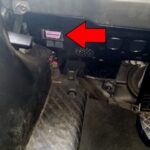The Ford Ranger embraced OBD2 (On-Board Diagnostics II) in the 1996 model year, marking a significant shift in automotive diagnostics. This article delves into the intricacies of this early OBD2 system in the Ranger, focusing on compatibility with ELM327 scan tools and available software options.
Understanding the communication protocols and limitations of this first-generation system is crucial for accurate diagnostics. While generic OBD2 scanners can retrieve basic information like trouble codes, accessing manufacturer-specific data often requires specialized software and a deeper understanding of the Ranger’s system.
Navigating Early OBD2 in the 1996 Ford Ranger
The 1996 Ranger utilizes the SAE J1850 PWM (Pulse Width Modulation) communication protocol for OBD2. This differs from the CAN (Controller Area Network) protocol found in later vehicles. Selecting an ELM327 adapter and software compatible with J1850 PWM is essential for proper functionality.
ELM327 Compatibility: While many inexpensive ELM327 adapters claim compatibility, real-world performance can vary. Opting for a reputable brand with a faster refresh rate (30+ scans/second) ensures smooth data streaming for live monitoring. Lower refresh rates can lead to lag and inaccurate readings, especially when observing multiple parameters simultaneously.
Software Options for the First-Year OBD2 Ranger:
Several software options exist for interfacing with the 1996 Ranger’s OBD2 system:
-
Torque Pro: A popular Android app offering an intuitive interface and basic functionality. While excellent for reading and clearing codes, its access to manufacturer-specific PIDs (Parameter IDs) for the early Ranger may be limited.
-
Car Gauge Pro: Known for its versatility and extensive PID support. It can potentially unlock more in-depth data from the Ranger’s various modules but requires technical proficiency due to its complex interface. Compatibility with the 1996 Ranger’s specific modules needs verification.
-
Dash Command: Offers tailored functionality for specific vehicle makes and models. Purchasing specific Ford or GM PID packs might be necessary to access advanced data in the 1996 Ranger. Dash Command is known for reliable compatibility with early OBD2 systems.
-
Professional-Grade Software: Options like ScanXL Pro or HP Tuners offer comprehensive diagnostics capabilities, including bidirectional communication for tasks like sensor relearns and injector balance tests. These solutions come with a higher price tag and cater to advanced users.
Challenges and Considerations
The first year of OBD2 implementation often presented unique challenges:
-
Limited PID Availability: Accessing manufacturer-specific data might require dedicated software or custom configurations. Generic OBD2 scanners may only provide basic information.
-
Communication Protocol Variations: Understanding the J1850 PWM protocol specific to the 1996 Ranger is crucial for successful diagnostics.
-
Software Compatibility: Not all software options fully support the early OBD2 implementation in the Ranger. Thorough research and testing are essential to ensure compatibility before purchasing.
Conclusion
Successfully diagnosing a first-year OBD2 Ford Ranger requires careful consideration of the vehicle’s communication protocol and software capabilities. Choosing a reliable ELM327 adapter and compatible software tailored to the 1996 Ranger’s specific needs is essential for accurate readings and comprehensive diagnostics. While generic solutions can provide basic information, accessing advanced data often necessitates specialized tools and software. Remember to always consult reputable sources and verify compatibility before making any purchases.

